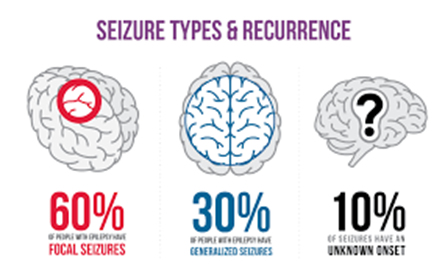Seizures
Overview
A seizure is a sudden,
uncontrolled electrical disturbance in the brain. It can cause changes in your
behavior, movements or feelings, and in levels of consciousness. Having two or
more seizures at least 24 hours apart that aren't brought on by an identifiable
cause is generally considered to be epilepsy.
There are many types of
seizures, which range in symptoms and severity. Seizure types vary by where in
the brain they begin and how far they spread. Most seizures last from 30
seconds to two minutes. A seizure that lasts longer than five minutes is a
medical emergency.
Seizures are more common
than you might think. Seizures can happen after a stroke, a closed head injury,
an infection such as meningitis or another illness. Many times, though, the
cause of a seizure is unknown.
Most seizure disorders can
be controlled with medication, but management of seizures can still have a
significant impact on your daily life. The good news is that you can work with
your doctor to balance seizure control and medication side effects.
Symptoms
With a seizure, signs and
symptoms can range from mild to severe and vary depending on the type of
seizure. Seizure signs and symptoms may include:
Temporary confusion
A staring spell
Uncontrollable jerking
movements of the arms and legs
Loss of consciousness or
awareness
Cognitive or emotional
symptoms, such as fear, anxiety or deja vu
Doctors generally classify
seizures as either focal or generalized, based on how and where abnormal brain
activity begins. Seizures may also be classified as unknown onset, if how the
seizure began isn't known.
Focal seizures
Focal seizures result from
abnormal electrical activity in one area of your brain. Focal seizures can
occur with or without loss of consciousness:
Focal seizures with
impaired awareness. These seizures involve a change or loss
of consciousness or awareness that feels like being in a dream. You may seem
awake, but you stare into space and do not respond normally to your environment
or you perform repetitive movements. These may include hand rubbing, mouth
movements, repeating certain words or walking in circles. You may not remember
the seizure or even know that it occurred.
Focal seizures
without loss of consciousness. These seizures may alter
emotions or change the way things look, smell, feel, taste or sound, but you
don't lose consciousness. You may suddenly feel angry, joyful or sad. Some
people have nausea or unusual feelings that are difficult to describe. These seizures
may also result in difficulty speaking, involuntary jerking of a body part,
such as an arm or a leg, and spontaneous sensory symptoms such as tingling,
dizziness and seeing flashing lights.
Symptoms of focal seizures
may be confused with other neurological disorders, such as migraine, narcolepsy
or mental illness.
Generalized seizures
Seizures that appear to
involve all areas of the brain are called generalized seizures. Different types
of generalized seizures include:
Absence seizures.
Absence seizures, previously known as petit mal seizures, often occur in
children and are characterized by staring into space or by subtle body
movements, such as eye blinking or lip smacking. They usually last for five to
10 seconds but may happen up to hundreds of times per day. These seizures may
occur in clusters and cause a brief loss of awareness.
Tonic seizures.
Tonic seizures cause stiffening of your muscles. These seizures usually affect
muscles in your back, arms and legs and may cause you to lose consciousness and
fall to the ground.
Atonic seizures.
Atonic seizures, also known as drop seizures, cause a loss of muscle control,
which may cause you to suddenly collapse, fall down or drop your head.
Clonic seizures.
Clonic seizures are associated with repeated or rhythmic, jerking muscle
movements. These seizures usually affect the neck, face and arms on both sides
of the body.
Myoclonic seizures.
Myoclonic seizures usually appear as sudden brief jerks or twitches of your
arms and legs. There is often no loss of consciousness.
Tonic-clonic
seizures. Tonic-clonic seizures, previously known as
grand mal seizures, are the most dramatic type of epileptic seizure and can
cause an abrupt loss of consciousness, body stiffening and shaking, and
sometimes loss of bladder control or biting your tongue. They may last for
several minutes.
When to see a doctor
Seek immediate medical help
if any of the following occurs:
The seizure lasts more than
five minutes.
Breathing or consciousness
doesn't return after the seizure stops.
A second seizure follows
immediately.
You have a high fever.
You're experiencing heat
exhaustion.
You're pregnant.
You have diabetes.
You've injured yourself
during the seizure.
If you experience a seizure
for the first time, seek medical advice.
Causes
Nerve cells (neurons) in the
brain create, send and receive electrical impulses, which allow the brain's
nerve cells to communicate. Anything that disrupts these communication pathways
can lead to a seizure. Some types of seizure disorders may be caused by genetic
mutations.
The most common cause of seizures
is epilepsy. But not every person who has a seizure has epilepsy. Sometimes
seizures may be caused or triggered by:
High fever, which can be
associated with an infection such as meningitis
Lack of sleep
Flashing lights, moving
patterns or other visual stimulants
Low blood sodium
(hyponatremia), which can happen with diuretic therapy
Medications, such as certain
pain relievers, antidepressants or smoking cessation therapies, that lower the
seizure threshold
Head trauma that causes an
area of bleeding in the brain
Abnormalities of the blood
vessels in the brain.
Jan Ricks Jennings, MHA,
LFACHE
Senior Consultant
Senior Management Resources,
LLC
Jan.JenningsBlog.Blogspot.com
412.913.0636 Cell
724.733.0509 Office
July 20, 2022




No comments:
Post a Comment